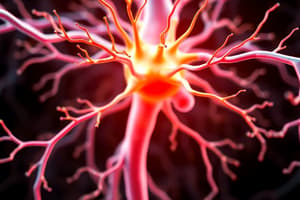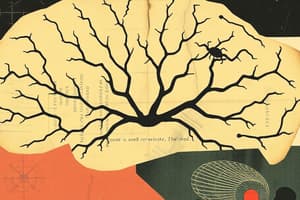Podcast
Questions and Answers
What is the primary effect of the release of inhibitory neurotransmitters, such as GABA or glycine, on the postsynaptic cell membrane?
What is the primary effect of the release of inhibitory neurotransmitters, such as GABA or glycine, on the postsynaptic cell membrane?
- Hyperpolarization and decreased neural excitability (correct)
- Decreased permeability to potassium ions
- Increased permeability to sodium ions
- Depolarization and increased neural excitability
What is the result of the combined effects of EPSP and IPSP on a neuron?
What is the result of the combined effects of EPSP and IPSP on a neuron?
- Either increased or decreased likelihood, depending on the strength of the EPSP and IPSP
- No effect on action potential generation
- Increased likelihood of action potential generation
- Decreased likelihood of action potential generation (correct)
What is the effect of acetylcholine binding to its receptor on the neuron?
What is the effect of acetylcholine binding to its receptor on the neuron?
- No effect on neural excitability
- Depolarization and increased neural excitability (correct)
- Hyperpolarization and decreased neural excitability
- Either hyperpolarization or depolarization, depending on the strength of the signal
What is the result of an influx of chloride ions (Cl−) and efflux of potassium ions (K+) on the neuron?
What is the result of an influx of chloride ions (Cl−) and efflux of potassium ions (K+) on the neuron?
What is the effect of Na+ entry into the neuron?
What is the effect of Na+ entry into the neuron?
What is a characteristic of neurotransmitters binding to their receptors on the postsynaptic cell membrane?
What is a characteristic of neurotransmitters binding to their receptors on the postsynaptic cell membrane?
What is the result of stimulation of inhibitory neurons on the postsynaptic cell?
What is the result of stimulation of inhibitory neurons on the postsynaptic cell?
What is a characteristic of the combined effects of EPSP and IPSP on a neuron?
What is a characteristic of the combined effects of EPSP and IPSP on a neuron?
What is the overall action of neurotransmitters on a neuron?
What is the overall action of neurotransmitters on a neuron?
What is the characteristic of neuronal tracts in the CNS?
What is the characteristic of neuronal tracts in the CNS?
Which disease is characterized by the progressive loss of selected neurons in discrete brain areas?
Which disease is characterized by the progressive loss of selected neurons in discrete brain areas?
What is the result of the progressive loss of selected neurons in discrete brain areas?
What is the result of the progressive loss of selected neurons in discrete brain areas?
What is the role of GABA receptors in the postsynaptic neuron membrane?
What is the role of GABA receptors in the postsynaptic neuron membrane?
What is the consequence of an empty receptor in the postsynaptic neuron membrane?
What is the consequence of an empty receptor in the postsynaptic neuron membrane?
What is the potential therapeutic approach for neurodegenerative diseases?
What is the potential therapeutic approach for neurodegenerative diseases?
What is the common characteristic of neurodegenerative diseases mentioned in the text?
What is the common characteristic of neurodegenerative diseases mentioned in the text?
Which of the following medications is not used to treat Alzheimer's disease?
Which of the following medications is not used to treat Alzheimer's disease?
What is the primary function of neurotransmitters in the CNS?
What is the primary function of neurotransmitters in the CNS?
Which of the following medications is used to treat Parkinsonian symptoms?
Which of the following medications is used to treat Parkinsonian symptoms?
What is a key difference between neurons in the peripheral ANS and those in the CNS?
What is a key difference between neurons in the peripheral ANS and those in the CNS?
Which of the following medications is used to regulate dopamine levels in the brain?
Which of the following medications is used to regulate dopamine levels in the brain?
What is the main cause of neurotransmitter imbalance in Alzheimer's disease?
What is the main cause of neurotransmitter imbalance in Alzheimer's disease?
Which of the following medications is used to treat dementia-related symptoms?
Which of the following medications is used to treat dementia-related symptoms?
What is the primary mechanism of action of dopamine agonists in the treatment of Parkinson's disease?
What is the primary mechanism of action of dopamine agonists in the treatment of Parkinson's disease?
Flashcards are hidden until you start studying
Study Notes
Neurotransmission in the CNS
- Neurotransmitters are not uniformly distributed in the CNS, but are localized in specific clusters of neurons.
- The axons of these neurons may synapse with specific regions of the brain, making many neuronal tracts seem to be chemically coded.
- This chemical coding may offer greater opportunity for selective modulation of certain neural pathways.
Neurodegenerative Diseases
- Neurodegenerative diseases of the CNS include Parkinson's disease, Alzheimer's disease, MS, and ALS.
- These diseases are characterized by the progressive loss of selected neurons in discrete brain areas, resulting in characteristic disorders of movement, cognition, or both.
Inhibitory Neurotransmission
- Stimulation of inhibitory neurons releases neurotransmitter molecules, such as GABA or glycine, which bind to receptors on the postsynaptic cell membrane.
- This causes a transient increase in the permeability of specific ions, such as potassium (K+) and chloride (Cl−).
- The influx of Cl− and efflux of K+ cause a weak hyperpolarization, or IPSP, that moves the postsynaptic potential away from its firing threshold.
Excitatory Neurotransmission
- Binding of the excitatory neurotransmitter, acetylcholine, causes depolarization of the neuron.
- Entry of Na+ depolarizes the cell and increases neural excitability.
Combined Effects of EPSP and IPSP
- Most neurons in the CNS receive both EPSP and IPSP input.
- Several different types of neurotransmitters may act on the same neuron, but each binds to its own specific receptor.
Parkinson's Disease
- Overview of Parkinson's disease: a neurodegenerative disease characterized by the progressive loss of selected neurons in discrete brain areas.
Drugs for Neurodegenerative Diseases
- Medications for Parkinson's disease: Procyclidine (KEMADRIN), Rasagiline (AZILECT), Ropinirole (REQUIP), Rotigotine (NEUPRO), Selegiline (ELDEPRYL, ZELAPAR), Tolcapone (TASMAR), Trihexyphenidyl (ARTANE)
- Medications for Alzheimer's disease: Donepezil (ARICEPT), Galantamine (RAZADYNE), Memantine (NAMENDA), Rivastigmine (EXELON)
Studying That Suits You
Use AI to generate personalized quizzes and flashcards to suit your learning preferences.




